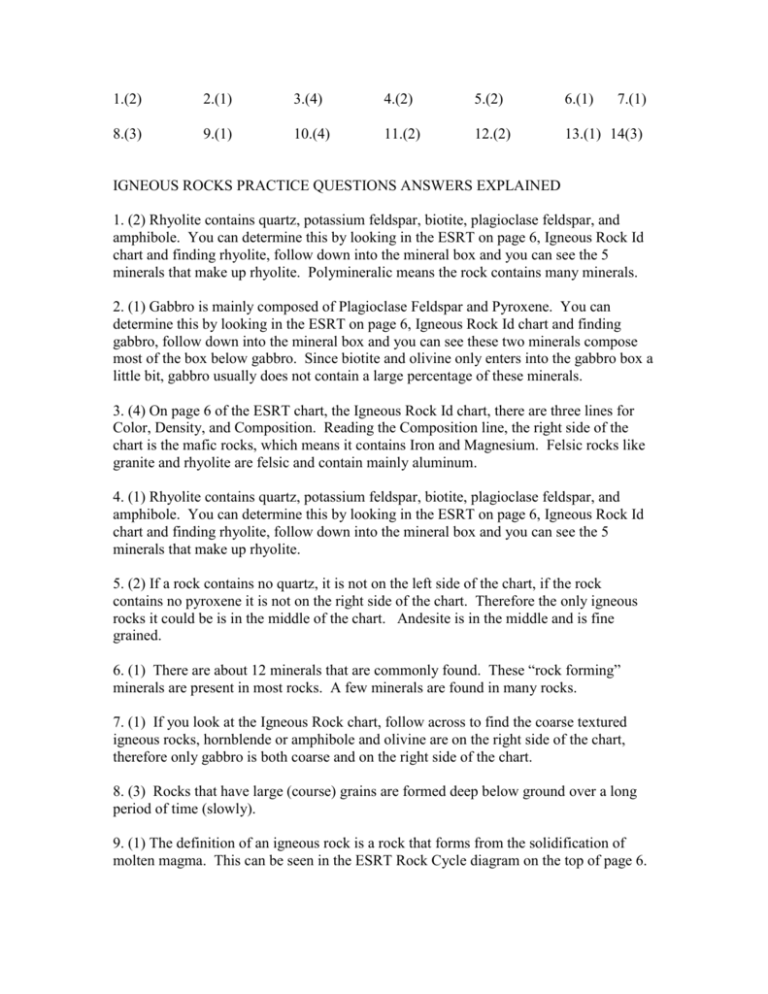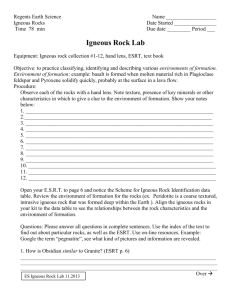minerals fine-grained
advertisement

1.(2) 2.(1) 3.(4) 4.(2) 5.(2) 6.(1) 7.(1) 8.(3) 9.(1) 10.(4) 11.(2) 12.(2) 13.(1) 14(3) IGNEOUS ROCKS PRACTICE QUESTIONS ANSWERS EXPLAINED 1. (2) Rhyolite contains quartz, potassium feldspar, biotite, plagioclase feldspar, and amphibole. You can determine this by looking in the ESRT on page 6, Igneous Rock Id chart and finding rhyolite, follow down into the mineral box and you can see the 5 minerals that make up rhyolite. Polymineralic means the rock contains many minerals. 2. (1) Gabbro is mainly composed of Plagioclase Feldspar and Pyroxene. You can determine this by looking in the ESRT on page 6, Igneous Rock Id chart and finding gabbro, follow down into the mineral box and you can see these two minerals compose most of the box below gabbro. Since biotite and olivine only enters into the gabbro box a little bit, gabbro usually does not contain a large percentage of these minerals. 3. (4) On page 6 of the ESRT chart, the Igneous Rock Id chart, there are three lines for Color, Density, and Composition. Reading the Composition line, the right side of the chart is the mafic rocks, which means it contains Iron and Magnesium. Felsic rocks like granite and rhyolite are felsic and contain mainly aluminum. 4. (1) Rhyolite contains quartz, potassium feldspar, biotite, plagioclase feldspar, and amphibole. You can determine this by looking in the ESRT on page 6, Igneous Rock Id chart and finding rhyolite, follow down into the mineral box and you can see the 5 minerals that make up rhyolite. 5. (2) If a rock contains no quartz, it is not on the left side of the chart, if the rock contains no pyroxene it is not on the right side of the chart. Therefore the only igneous rocks it could be is in the middle of the chart. Andesite is in the middle and is fine grained. 6. (1) There are about 12 minerals that are commonly found. These “rock forming” minerals are present in most rocks. A few minerals are found in many rocks. 7. (1) If you look at the Igneous Rock chart, follow across to find the coarse textured igneous rocks, hornblende or amphibole and olivine are on the right side of the chart, therefore only gabbro is both coarse and on the right side of the chart. 8. (3) Rocks that have large (course) grains are formed deep below ground over a long period of time (slowly). 9. (1) The definition of an igneous rock is a rock that forms from the solidification of molten magma. This can be seen in the ESRT Rock Cycle diagram on the top of page 6. 10. (4) Slow cooling of magma will create large crystals in an igneous rock. 11. (2) According to the Igneous Rock Chart, potassium feldspar and quartz are found in granite but looking at the mineral part of the chart these minerals are not present on the right side of the chart where gabbro is located. 12. (2) Lava is liquid rock on the Earth’s surface which will form an extrusive igneous rock. Extrusive igneous rocks cool quickly and form fine-grained rocks. Dark colored rocks are mafic according to the composition line of the Igneous Rock Chart on page 6 of the ESRT. 13. (1) According to the ESRT page 6 Igneous Rock chart. If an igneous rock contains quartz then it must be on the right side of the chart. Extrusive rocks have a fine or glassy texture, rhyolite is both fine grained (extrusive) and contains quartz (on the left side of the chart). 14. (3) Fine-grained igneous rocks form quickly at the Earth’s surface from liquid rock (lava)








